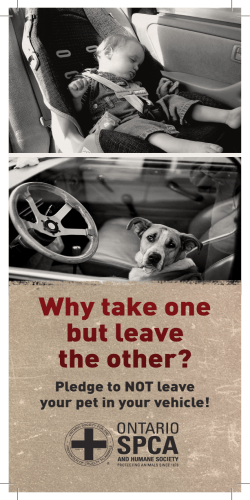
IF YOU KENNEL YOUR DOG OUTDOORS, THE •
IF YOU KENNEL YOUR DOG OUTDOORS, THE ONTARIO SPCA STRONGLY RECOMMENDS THAT: Your local Ontario SPCA Community: • Dogs should NOT be chained. Severe physical injury, even death, can easily result. Chained dogs also suffer pshychologically and they are 80% more likely to bite. Fence your yard, don’t chain your dog! • A dog that is kenneled outdoors should always spend time indoors with the opportunity for socializing and play; • Ideally the roof of your doghouse should be removable to make cleaning the interior of the doghouse easier. ADDITIONAL CONSIDERATIONS Some breeds of dogs can live outside during the winter, if they are provided with an insulated doghouse of the proper dimensions. The dimensions are directly related to the size of the dog and are critically important if the dog is to maintain warmth in the doghouse with its own body heat. Through its province-wide network of 50 plus Communities, the Ontario SPCA is one of the largest, most responsive animal welfare organizations in the country, providing care and shelter for tens of thousands of animals every year. • Dogs should be acclimatized to outdoor living when they are young and the weather is warm. • During severe weather, dogs may have to be brought inside the family home. • Aged, young or infirm dogs should not be housed outdoors, especially during cold weather. • Dogs with short coats are prone to frostbite and can not endure the cold temperatures very easily. The Ontario SPCA is unique amongst animal welfare organizations in Ontario: the Ontario SPCA Act mandates the Society to enforce animal cruelty laws and provides Society Branch and Affiliate investigators with police powers to do so. For more information about the Ontario SPCA, its programs and services please explore our website at ontariospca.ca or call 1-888-668-7722 Doghouse exteriors should be finished with a weatherproof material or nonleaded paint. Changing the location of the doghouse will allow you to control the effects of the sun, shade and wind. Bedding material should be put in the sleeping area, straw is recommened. It is not advisable to use blankets. Change the bedding every 1 to 2 weeks and keep the house interior clean. A burlap or canvas outside flap should be used to provide more weather protection in the winter and can be removed in the summer. The house should be elevated on bricks or cinder blocks to keep the floor dry and it may then be necessary to provide a low base platform which will allow the dog access into the raised house and an area off the ground on which to lie when outside its house. If your present doghouse has a peaked roof and is large enough, it may be possible to install an insulated ceiling and a separate hallway, making it warmer in the winter and preventing ice jams on top. In addition, a small rainproof vent could help to dissipate any moisture inside, thereby reducing the possibility of mould. 16586 Woodbine Ave RR3, Newmarket, ON L3Y 4W1 • 1 (888) 668-7722 • www.ontariospca.ca • [email protected] The Ontario Society for the Prevention of Cruelty to Animals (Ontario SPCA): Protecting animals since 1873, the Ontario SPCA is a registered charity comprised of over 50 Communities relying primarily on donations to fund animal protection, care and rehabilitation; advocacy; and humane education. The Ontario SPCA Act mandates the Society to enforce animal cruelty laws and provides Society investigators with police powers to do so – making the Ontario SPCA unique among animal welfare organizations in the province. The Ontario SPCA is an affiliated with the Royal Society for the Prevention of Cruelty to Animals. Adopt – Volunteer – Donate! Charitable Business Number 88969 1044 RR0002 DOGHOUSE CONSTRUCTION The doghouse illustrated in Figure #2 can be simply made from readily available materials. Basically, it is a frame of 2” x 2”s, with a 1/2” or 3/4” weatherproof plywood exterior. It has an entrance and hallway that are separated from a sleeping area. Walls, floors and ceiling of the sleeping area are insulated with 1 1/2 ” styrofoam sheets which, in turn, are covered on the inside with a panelling of 1/4” hardboard or similar material. TABLE 1 FIGURE 2 Use shavings or straw bedding in sleeping area Hinged roof of exterior plywood (1/2” to 3/4”) 2” x 2” Frame on roof ceiling to hold insulation panel over sleeping area Entire frame of 2” x 2” SIZE OF SLEEPING AREA FLOOR SPACE For each inch of your dog’s height (measured from top of shoulder to ground), allow 36 square inches of floor space. For example, a dog 12 inches tall needs 432 square inches of floor space, or a floor area of 16” x 27” = 432 square inches. HEIGHT OF SLEEPING AREA Add 1 or 2 inches to your dog’s measurement when in a sitting position (from top of head to ground), in order to determine the ceiling height. For example, a dog 12 inches tall will have a sitting height of about 14 inches and the doghouse ceiling should be 15 or 16 inches high. OVERALL DOGHOUSE DIMENSIONS For example, a Dalmatian (20” tall, sitting height 23”) doghouse should measure: sleeping area – 20” x 36”; hall area – 12” x 20”; ceiling height – 25”; doorways – 10” square; roof – 36” x 72”. Inner doorway Hall or vestibule 4” or 5” door sill (same on inside door) Elevate on brick or cinder block or on platform Inside walls of 1/4” plywood or hardboard 2” x 4” support frame/skirt 1/2” exterior plywood 1 1/2” styrofoam insulation For other breeds’ doghouse dimensions, see Table 2 DOGHOUSE DIMENSIONS FOR DOGS OF VARIOUS SIZES TABLE 2 10” - shoulder 12” - sitting 12” - shoulder 14” - sitting 16” - shoulder 18” - sitting 20” - shoulder 23” - sitting 24” - shoulder 27” - sitting 28” - shoulder 32” - sitting Toy Poodles Scottish Terriers Miniature Poodles Welsh Corgis Shetland Sheepdogs Cocker Spaniels Dalmations Pointers Retrievers Collies Newfoundlands St. Bernards SLEEPING AREA 15” X 24” 16” X 27” 18 “ X 31” 20” X 36” 22” X 39” 25” X 43” HALL AREA 11” X 15” 12” X 16” 12 “ X 18” 12” X 20” 14” X 22” 16” X 25” COMBINED AREA 15” X 35” 16” X 39” 18 “ X 43” 20” X 48” 22” X 53” 25” X 59” CEILING HEIGHT 14” 16” 20” 25” 30” 36” DOORWAYS 7” square 8” square 9” square 10” square 11” x 13” 12” x 16” ROOF 25” X 48” 26” X 54” 34 “ X 62” 36” X 72” 38” X 78” 41” X 86” PLATFORM (if used) 25” X 48” 26” X 54” 34 “ X 62” 36” X 72” 38” X 78” 41” X 86” Areas and ceiling heights are inside measurements (Sleeping & Hall) BREED SHOULDER HEIGHTS Poodle, toy Scottish Terrier Poodle, miniature Welsh Corgi Sheland Sheepdog Fox Terrier American Cocker Poodle, standard Dalmation Boxer Collie Retriever German Shepherd Old English Sheepdog Airedale Doberman St. Bernard Newfoundland Great Dane Russian Wolfhound up to 10” 10” 10” to 14” 11” to 12” 13” to 16” 15” to 15 1/2” 15” to 15 1/2” 15” to 16” 20” to 23” 22” to 24” 22” to 24” 22” to 25” 22” to 26” 22” 23” 25” 25” to 27 1/2” 26” to 28” 28” to 30” 28” to 31” THE OSPCA ACT - STANDARDS OF CARE REQUIRES OUTDOOR DOGS TO HAVE THE FOLLOWING: (1) Every dog that lives primarily outdoors must be provided with a structurally sound enclosure for its use at all times (2) The enclosure must be weather-proofed and insulated. (3) The size and design of the enclosure must be adequate and appropriate for the dog. (4) A chain, rope or similar restraining device used to tether a dog that lives primarily outdoors, (a) must be at least three meters long; (b) must allow the dog to move safely and unrestricted (except by its length); and (c) must allow the dog to have access to adequate and appropriate water and shelter. Ontario Regulation 60/09 - Made: February 24, 2009
© Copyright 2025













